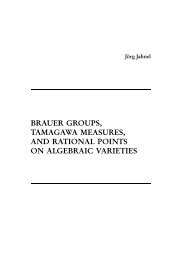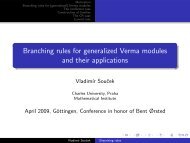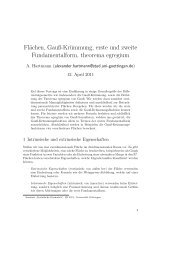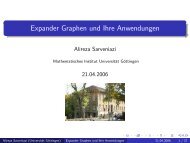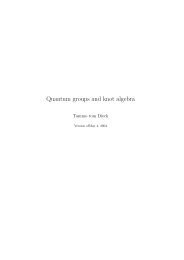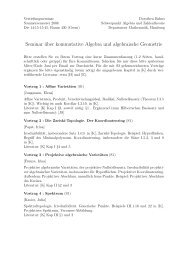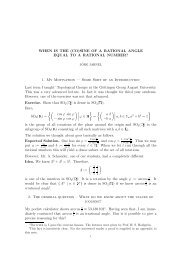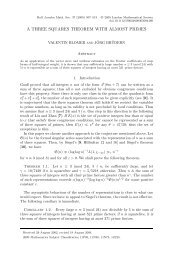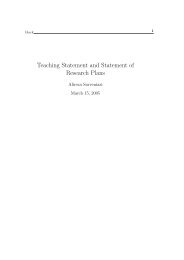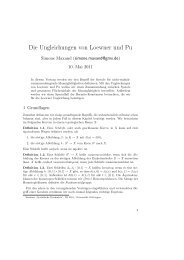Research statement (short version)
Research statement (short version)
Research statement (short version)
You also want an ePaper? Increase the reach of your titles
YUMPU automatically turns print PDFs into web optimized ePapers that Google loves.
<strong>Research</strong> Statement<br />
I am a mathematical physicist currently working in gauge theories, string theory and algebraic<br />
topology, in particular K-theory. My interests in mathematics are very wide, focusing in the interface<br />
between topology, geometry and algebra, and in its relation with physics. I use and develop<br />
geometrical and topological methods to solve mathematical problems arising from string and gauge<br />
theories, and as a tool to give rigorous definitions to physical objects. In particular, my favourite<br />
fields of study include the geometry of fiber bundles, Dirac operators, and Index theorems, and<br />
the homological algebra of generalised homology and cohomology theories, with an emphasis on<br />
K-theory.<br />
Here follows a more detailed commentary on the projects I have been involved in.<br />
Gauge theories and differential cohomology. Gauge theories of p-forms play an important<br />
role in theoretical physics, as they appear as low-energy limit of string theories, e.g. the theory of<br />
Ramond-Ramond fields. In the same spirit as nonabelian gauge theories, they constitute a generalisation<br />
of Maxwell electromagnetism to the case in which the fieldstrenght is an higher differential<br />
form. Until recently, though, a rigorous mathematical description of these theories in topologically<br />
nontrivial backgrounds was lacking. In [5] the author proposes that these gauge theories are better<br />
described via generalised differential cohomology, an extension of ordinary cohomology through<br />
differential forms. In the same spirit, in [7] we study the gauge theory of Ramond-Ramond fields<br />
on global orbifolds of finite type. We introduce physical applications of the methods of Bredon<br />
cohomology [2], a powerful equivariant cohomology theory, showing that it perfectly captures the<br />
properties of the physical theory under study. Through an equivariant Chern character, we provide<br />
new Wess-Zumino couplings of topologically trivial Ramond-Ramond fields to D-branes which generalise<br />
previous ones to deal with arbitrary spacetime manifolds. We use this couplings to derive<br />
a quantization rule for the total fieldstrenght of the theory, and we show that this is given by<br />
the equivariant Chern character. In particular, one of the main mathematical achievement of this<br />
work consists in a generalisation of differential K-theory suitable for orbifolds. Ideed, this is a new<br />
mathematical result. We prove that this theory satisfies similar properties to the ordinary one, and<br />
we use it to investigate the flat fields contributions in specific cases of interest.<br />
D-branes and K-homology. D-branes consist of boundary conditions in the two-dimensional<br />
conformal field theory underlying string theory, and can (sometimes) be represented as submanifolds<br />
of the spacetime on which open strings can be attached. Moreover, they come equiped with a<br />
vector bundle and a connection describing a gauge theory on the brane itself. It is known that they<br />
carry some form of charge, and that they are dynamical objects, rather than static ones. One of the<br />
main advances in a mathematical understanding of D-branes on arbitrary spacetime manifolds has<br />
been the description of their charges via K-theory [8]. In particular, K-theoretical methods have<br />
shown to be fundamental in detecting possible anomalies, e.g Freed-Witten anomaly in a string<br />
theory with D-branes backgrounds [4]. An alternative mathematical description of D-branes is<br />
given by K-homology [1], the generalised homology theory dual to K-theory. This can be defined<br />
topologically, or geometrically, via triples (M, E, ϕ), where M is a spin c manifold, E is a vector<br />
bundle over M, and ϕ is an embedding map, or analytically, via Fredholm modules. In particular,<br />
the topological K-homology encodes geometrical information on the possible D-branes wrapping a<br />
submanifold of the spacetime, and takes into account various dynamical effects. In [6] we apply<br />
KO-homology, dual to KO-theory, to study branes in a type I superstring theory. More specifically,
we develop a geometric description of KO-homology, and an analytic one, based on the KK-theory<br />
of real C ∗ - algebras. One of the main mathematical achievement of this work is an explicit construction<br />
of an isomorphism between the two descriptions, based on the Cl(n)-index theorem for<br />
real vector bundles. Via topological invariants, we construct a homological Chern character, and<br />
describe torsion effects in D-brane charges. Moreover, we elucidate the importance of the grading<br />
in the KO-homology groups, and give a better interpretation of its cycles in terms of wrapping<br />
D-branes. Finally, for the first time we apply K-homology to the study of Ramond-Ramond fluxes.<br />
The hydrogen atom and reduction. This is a project I was involved in soon after graduating,<br />
and before beginning my PH.D. studies.<br />
Reduction procedures have been widely used as a powerful tool in the study of classical systems,<br />
and symplectic manifolds with symmetries. It is known, in particular, that different classes of<br />
completely integrable systems can be obtained as reductions of free, or simpler systems in higher<br />
dimensions, allowing for a complete solution of the system’s dynamics. Although reduction procedures<br />
have had a lot of consideration in the classical setting, the same has not happened in the<br />
quantum setting, at least not in a systematic way. For this reason, through the study of the well<br />
know hydrogen atom, in [3] we try to make steps forward the development of a quantum reduction<br />
procedure. Our main point is based on the algebraic description of the classical reduction procedure,<br />
which translates as an homomorphism of Lie algebras of vector fields, associated to suitable<br />
maps between the configuration spaces. In the same spirit, we propose a quantum reduction procedure<br />
based on homomorphisms of algebras of differential operators on manifolds. In particular, we<br />
introduce a general notion of reduction for differential operators on an arbitrary manifold, which<br />
can be used in various physical context, as not necessarily linked to quantum mechanics. Then we<br />
apply this technique to show that the hydrogen atom in four dimension can be obtained as a quantum<br />
reduction of a family of harmonic oscillators, allowing an easy computation of its spectrum,<br />
and a straightforward analysis of its algebra of symmetries.<br />
Future <strong>Research</strong><br />
In my future reasearch I would continue to investigate the mathematical aspects of gauge and string<br />
theories in non trivial geometrical and topological settings. An interesting case is given by the homological<br />
analysis of D-branes when a B-field is present, where twisted K-homology is the right<br />
framework to be in. In particular, twisted K-homology comes in different geometric realisations,<br />
but it’s not clear which one encodes the correct description of D-branes. Indeed, investigating the<br />
mathematical relation among them can shed light on new physical phenomenons not yet seen in<br />
the current formalism.<br />
Another aspect I would concentrate on is the further development of the mathematical methods<br />
used in [7], in order to have a better understanding of the global properties of Ramond-Ramond<br />
fields on orbifolds, in particular their dynamics, and of nonperturbative aspects of orbifolded string<br />
theory, e.g. the presence of possible orbifold anomalies when D-branes are considered.<br />
As my interests span various fields of mathematics and physics, I will also be very willing to increase<br />
my knowledge of mathematical methods not only in the area of geometry, topology and algebra,<br />
but in the mathematics of (quantum) field theory in general.<br />
References<br />
[1] P. Baum and R.G. Douglas. K-homology and index theory. Proc. Symp. Pure Math. 38, 117–<br />
173 (1982)
[2] G. Bredon. Equivariant cohomology theories. Springer Lecture Notes in Math. 34 (1967)<br />
[3] A. D’Avanzo, G. Marmo, A. Valentino Reduction and Unfolding for Quantum Systems: the<br />
Hydrogen Atom, Int.J.Geom.Meth.Mod.Phys. 2 (2005) 1043-1062<br />
[4] D.S. Freed and E. Witten. Anomalies in string theory with D-branes. Asian J. Math. 3, 819–851<br />
(1999) (arXiv:hep-th/9907189)<br />
[5] D.S. Freed. Dirac charge quantization and generalized differential cohomology. Surv. Diff.<br />
Geom. VII, 129–194 (2000) (arXiv:hep-th/0011220).<br />
[6] R.M.G. Reis, R.J. Szabo and A. Valentino. KO-homology and Type I string theory. Preprint<br />
arXiv:hep-th/0610177 (2006), submitted to Comm. Math. Phys.<br />
[7] R. J. Szabo and A. Valentino, Ramond-Ramond Fields, Fractional Branes and Orbifold Differential<br />
K-Theory. Preprint (arXiv:0710.2773)[hep-th], submitted to Comm. Math. Phys.<br />
[8] E. Witten. D-branes and K-theory. J. High Energy Phys. 9812, 019 (1998) (arXiv:hepth/9810188)



